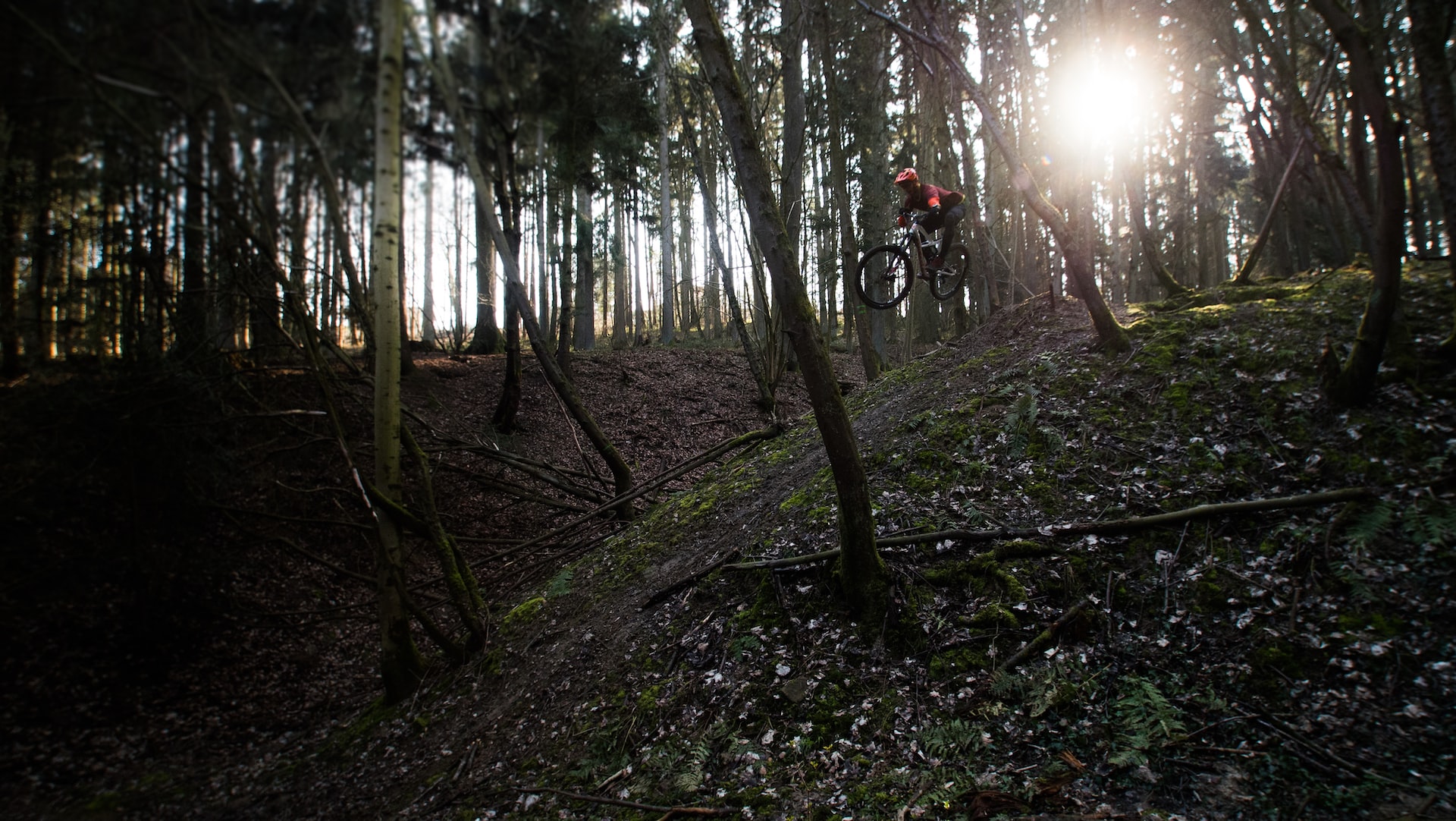For any mountain biker, regardless of experience level, the importance of having a solid foundation of skills cannot be understated. A strong foundation of fundamental mountain biking skills is essential to ensure safety and proper technique while giving riders the confidence to progress and take on more challenging rides. In this article, we will explore the role of a solid foundation in mountain biking and how it can help riders get the most out of their rides.
Traversing Mountains and Off-road Terrain
Mountain biking is an outdoor activity involving a specialized bicycle to traverse mountainous and off-road terrain. Mountain bikers typically ride on dirt trails, obstacles such as logs and rocks, and steep hills and inclines. Mountain biking is often seen as an extreme sport due to its challenging nature and the physical strain it can put on riders.
Why is a Solid Foundation Important for Mountain Biking?
A solid mountain biking foundation is essential to staying safe, in control, and enjoying the sport. A basic foundation of skills will also help them progress to more advanced techniques and allow riders to tackle even more technical and challenging trails. A solid foundation of mountain biking skills includes understanding the safety aspects of the sport, mastering essential techniques such as cornering, braking, and navigating obstacles, and developing an understanding of proper mountain bike maintenance and repair.
Benefits of Establishing a Solid Foundation in Mountain Biking
Establishing a solid foundation of mountain biking skills will result in a more enjoyable and safe experience. With the right skills and understanding, riders will be more confident tackling different obstacles and trails and be able to recognize and react to potential hazards, such as loose rocks and slippery surfaces. Additionally, riders will be better equipped to maintain their mountain bike, allowing them to keep their cycle running correctly and preventing any repair bills.
How to Develop a Solid Foundation in Mountain Biking
Developing a solid foundation in mountain biking requires commitment and dedication to mastering the basics. A great starting point is to take a mountain biking class to learn the essential safety principles and techniques. Additionally, riders should invest in quality mountain biking gear and use it properly to ensure safety and performance. Finally, riders should hit the trails as often as possible to continue to develop and perfect their mountain biking skills.
Benefits of a Sound Base
Having a sound base of mountain biking skills is essential for developing dynamic and effective body control. When moving down the trail, a rider must be able to move their body to absorb the terrain, navigate obstacles, and maintain balance. This type of body control requires much practice and experience, but it is attainable and necessary for safe and enjoyable mountain biking. With a solid foundation of mountain biking skills, riders can stay better connected to their bike and the terrain as they move around obstacles, increasing their balance and agility.
Fundamental Techniques
A solid mountain biking foundation provides the opportunity to master essential techniques. Practicing the basics is necessary for progressing to more advanced trail features. Developing a tangible sense of the fundamentals will create an excellent foundation for building more complex skills, such as wheel lifts, drops, and cornering. Through practice and repetition, riders can more quickly and confidently ride rugged terrain.
Stress Reduction
Having a sound base of mountain biking skills can also allow for less stress and fewer mistakes when confronted with a technical section of the trail. Knowing the fundamentals, such as body position and how to shift weight, will result in fewer mistakes, better flow, and more riding confidence. This allows riders to enjoy their time on the trail without worrying about their technical ability.
Progressions Galore
A sound base of mountain biking skills also unlocks a wealth of progression opportunities. With a solid understanding of the fundamentals, riders can focus on perfecting their technique and enjoy learning the skills they need to progress to the next level. These progressions can be translated to bike park features, such as jumps, lines, and drop-offs, as well as more advanced cross-country features like rock gardens and technical descents. With a strong foundation, riders can challenge themselves and reach new heights in their mountain biking skills.
Safety-Focused Riding
Riding with a sound base of mountain biking skills can also lead to a much safer overall experience. With a greater understanding of the basics, riders can be more aware of their abilities and make more informed decisions about the trails they are attempting. This can prevent serious injury due to mistakes or overestimating one’s abilities. Moreover, practicing the basics can improve a rider’s response time in the face of unexpected terrain or trail features, leading to quicker and safer reactions.
Developing Good Technique
It is essential to have a solid basic knowledge of mountain biking before attempting to develop advanced skills. The basics of mountain biking include a proper technique for shifting gears, braking, pedaling, cornering, and body positioning. Understanding the importance of body positioning is essential, as this can make or break your performance on the trails. Additionally, having a basic understanding of the appropriate gear that can be used to enhance your ride can help you to make the most out of your rides.
Practice Mountain Biking Skills Regularly
To become an expert mountain biker, you must regularly practice different mountain biking skills. Practicing techniques can often help you become more efficient and improve your speed, agility, and overall performance. It is essential to practice the different skills in different terrain and conditions, as this will help you to become more prepared for different riding scenarios. Additionally, riding with experienced riders can help you to develop good technique more quickly.
Receive Instruction from an Experienced Rider
If you are looking to take your mountain biking skills to the next level, it may be beneficial to seek instruction from an experienced rider. A professional mountain biker can provide insight into the techniques used to improve performance. Additionally, they can help you to understand the importance of good strategy, which can ultimately make you a better mountain biker.
Utilize Safety Gear and Equipment
The proper safety gear and equipment are essential to ensure an enjoyable and safe mountain biking experience. Using the right protective gear, such as a helmet, gloves, and knee and elbow pads, can help to prevent injury and reduce the risk of serious accidents. Additionally, having the right bike and proper maintenance can help ensure you get the most out of your riding experience.
Developing Positive Mental Attitude
Mountain biking requires a strong mental attitude to succeed. It is essential to develop a positive mindset while out on the trails, as this can help to enhance your performance. Creating a positive attitude can also allow you to push your limits and efficiently overcome obstacles. Additionally, having a positive attitude can make for a more enjoyable overall experience.
Core Strengthening Exercises
Mountain biking is physically demanding and requires excellent core strength and power. To be successful and safe on the trails, it’s crucial to have a solid foundation in mountain biking skills. One way to improve your skills is to focus on core strengthening exercises. These exercises can help you develop the strength, stability, and flexibility needed to perform at a high level.
Using Pilates Exercises for Core Strength Building
Pilates is a popular form of exercise that is designed to strengthen and tone the core muscles. Pilates can be used to train the core muscles to help with the stability and balance needed to maneuver over rough terrain. It can also help to improve posture, which can lead to increased power output and better performance on the bike.
Outdoor Core Strength Exercises
You can also do core strengthening exercises without access to a Pilates studio by doing exercises outdoors, such as calisthenics, mountain climbers, and planks. These exercises are designed to isolate the core muscles and develop a strong foundation for mountain biking. Other outdoor activities that can help improve balance and stability include biking, running, and jumping rope.
Incorporating Core Strength Training into Your Routine
Core exercises should be incorporated into your regular mountain biking routine. Doing core exercises before, during, and after your rides can help you stay balanced and focused. Regular core workouts can also help to reduce the risk of injury while mountain biking.
Focusing on core strengthening exercises can build a solid foundation to help you master mountain biking skills. With strong core muscles, you’ll be able to increase your power output and perform your best on the trails.
Practicing With Balance
Having a solid foundation in mountain biking skills is crucial for a rider to reach their full potential. Balance is essential for developing agility, speed, and control on the bike. Practicing balance can help riders improve their overall riding skills and comfort when traversing challenging terrain.
Mountain Bike Balance Exercises
One of the best ways to start building balance on the bike is to ride it. Practicing with balance means taking your time, especially when learning new techniques. Take the time to get comfortable with the basic skills before progressing onto more challenging terrain.
Climbing is a great way to practice balance. Start on an easy incline and progress towards more difficult terrain. Keep your weight on the pedals and your head and upper body in a neutral position when ascending. This will help you stay in control and ride with balance.
When descending, practice keeping your weight in the saddle and controlling your speed. This will help maintain a comfortable riding position and better control over the bike. Also, focus on getting the bike to turn quickly and accurately by using your body – keeping your elbows and upper body relaxed and letting the bike move underneath you.
Going Off-Road
Riding off-road is a great way to practice balance and develop mountain biking skills. Start by tackling small bumps and logs before progressing to more technical terrain. Focus on controlling the bike and staying in a comfortable riding position.
Lifting the front wheel off the ground is a great exercise to improve your balance. Lift the front wheel by using your arms and legs. As you become more proficient, focus on controlling the bike with your body weight and keeping the bike level. This will allow you to ride over obstacles and stay balanced.
Focusing on Balance
When practicing with balance, it is important to focus on controlling the bike and staying in a comfortable riding position. Keep your weight evenly distributed over the bike, and your upper body relaxed. This will help you stay in control and ride with balance.
Practicing with balance will also help you develop your skills when riding over obstacles. Focus on controlling the bike with your body weight and keeping your elbows, and upper body relaxed. With consistent practice and guidance, riders can develop their balance and become proficient mountain bikers.
Learning to Brake and Navigate
Mountain biking is a thrilling and exciting sport that requires skill, stamina, and good judgment. As such, having a solid foundation of core mountain biking skills is essential for safety and success. Learning how to brake and navigate correctly on a mountain bike is an integral part of this foundation.
Understanding Braking Basics
When it comes to mountain biking, the most crucial skill to master is how to control your speed correctly. Understanding how brakes work and interact with the terrain is vital to staying safe while riding. Braking is most effective when done in a controlled, progressive motion. To evenly distribute braking power, it is essential to use your front and rear brakes together. Additionally, it is important to remember that different brake pads can have extra stopping power, so make sure you are familiar with your particular bike’s setup.
Learning to Handle a Bike on Different Terrains
In addition to mastering an effective braking technique, it is vital to learn how to handle a bike on different types of terrain. When navigating obstacles, it is crucial to have good balance and understand how to position the body for maximum control best. Practicing these skills on a flat surface is a great way to develop the necessary skills before taking on more challenging terrain. It is also important to remember that riding speed should always be adjusted based on the landscape and the rider’s skill level.
Developing a Comfortable Riding Position
Developing a comfortable riding position is also vital for successful mountain biking. The ideal riding position should be comfortable yet provide control and stability. The handlebars should be at the same level as the rider’s seat, and the rider’s arms should be slightly bent when gripping the handlebars. Additionally, it is essential to remember to keep the legs barely bent to absorb shocks from the terrain.
Mastering the Basics for Mountain Bike Safety
Mountain biking is a fun and exhilarating sport, but it is crucial to take the time to develop a strong foundation of core skills to stay safe and enjoy the experience. Learning how to brake, handle the bike on different terrains, and create a comfortable riding position are all critical skills riders should practice to stay safe while on the trails. With the right approach and dedication, riders can build a solid mountain biking skills foundation that will set them up for success.
Moving on to More Difficult Trails
Once beginners have gained a solid foundation in mountain biking skills, it’s the perfect time to step up their difficulty level. Many trails available worldwide offer an exciting yet challenging experience for cyclists of all levels. Courses can range from easy, flat surfaces with smooth turn to more complicated, technical terrain.
Proper Preparation is Key
Before attempting more challenging trails, it’s essential to prepare properly. Research the route ahead of time to understand the level of difficulty and the types of obstacles and terrain that you will encounter. Make sure you have the proper bike setup and gear for the landscape.
Skills and Techniques to Learn
Before tackling more challenging trails, it is crucial to hone mountain biking skills, even if they are already reasonably proficient. Shifting gears quickly and efficiently, cornering with confidence, and braking effectively is essential for tackling more challenging trails.
Know Your Limits
Cyclists need to recognize their limits and understand when it is time to back off. Trying a trail before you are ready can be dangerous, so it is important not to push yourself too hard. If a track feels too complicated, it is better to turn back and try a less demanding one.
Tailor Your Training
Cyclists should also tailor their training to their own needs. To build strength and endurance, they should focus on specific exercises. Mountain biking is demanding, so cyclists must dedicate time to developing muscular strength, particularly in the legs and core.
Practice Makes Perfect
Finally, practice makes perfect, especially when mastering more challenging trails. Spend time on primary mountain trails first to get the hang of riding and maneuvering the terrain. Once you feel comfortable, start to challenge yourself with more demanding routes.
Mountain biking is an exciting and fulfilling sport. Understanding the importance of having a solid foundation in mountain biking skills is vital for cyclists to move on to more challenging trails. With proper preparation, training, and practice, any cyclist can enjoy the joys of more advanced mountain biking trails.
Staying Safe on the Trail
The importance of a solid foundation in mountain biking skills cannot be understated, nor can the importance of staying safe on the trail. Before heading out for a bike ride, riders must create an emergency plan. This plan should include information about who is going on the ride, where they are going, and an estimated return time. Riders should also bring essential items such as water, food, a first aid kit, a map, and a cell phone in an emergency. A whistle, a flashlight, and a watch should be added to the list for night rides.
Mind the Trail Conditions
When mountain biking, riders should be mindful of the trail conditions. Before attempting terrain-like jumps, riders should ensure they are comfortable with their bike and the obstacles they are trying. Conditions can also change quickly, so riders should remain aware of any changes to the terrain. This is particularly true after rain or snow, as the mountain trails can become slippery and dangerous.
Wear Appropriate Gear
In addition to having a solid foundation of mountain biking skills, riders should always wear the appropriate gear. This includes wearing a helmet that meets safety standards, long-sleeved shirts, long pants, and gloves for protection. Shoes that have a good grip and support the ankle are also essential. Furthermore, ensuring the bike is in good condition before heading out on the trail is crucial.
Handle Equipment Carefully
It is also essential to be mindful of how mountain bike equipment is handled. If repairs are needed, riders should carefully read their bike’s manual before attempting any repairs themselves. The rider should have the correct tool for the job if a device is required for repair. If riders do not have the right tool, they should take their bike to a mechanic.
Know the Risks
Finally, riders should be aware of the risks associated with mountain biking. Knowing these risks can help riders prepare and stay safe while on the trail. Hazards include injury, dehydration, loss, extreme weather, and getting stuck in rugged terrain. By keeping these risks in mind and following the tips outlined above, riders can ensure they remain safe while enjoying the sport of mountain biking.
Developing Expertise in Mountain Biking
A solid mountain biking foundation is essential to developing expertise in the sport. Building a strong knowledge base and practice in mountain biking can help riders progress in the sport, increase their confidence, and safely and successfully tackle challenging terrain. Core mountain biking skills such as braking and cornering, riding obstacles, jumping, and descending must be honed through practice and instruction to gain mastery. With a firm grasp on the basics, riders can then focus on improving their techniques, learning new skills, and pushing their boundaries to become better and more advanced. Through commitment and dedication, mountain bikers can reach the highest levels of skill and experience the thrill and joy of this fantastic sport.






Leave a reply